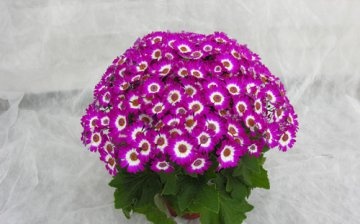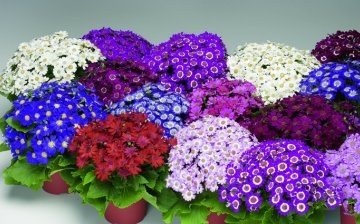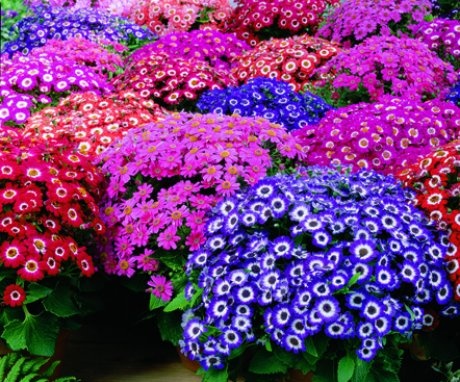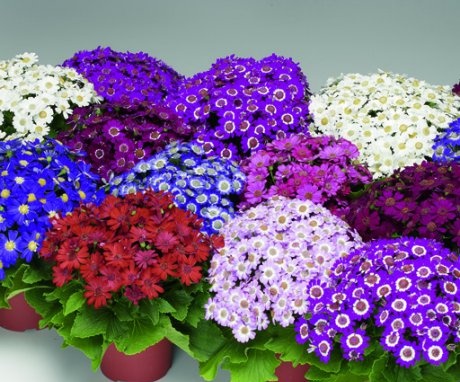Cineraria hybrid and care for it
Despite the fact that the genus cineraria has about 50 plants, only one is cultivated in indoor floriculture: hybrid cineraria. This flower is very beautiful and in some way even unique, because it begins to bloom at the end of winter and this period lasts only a few weeks, and after that the plant is simply removed. But this is not so scary, because it is easy to propagate cineraria, and it is not expensive to buy it.
Content:
Cineraria hybrid is a short plant that has large heart-shaped leaves on long petioles and a large number of flowers collected in a basket inflorescence, which can have a variety of colors and degrees of terry.
Conditions for growing hybrid cineraria
- Location
Like many indoor plants, cineraria loves well-lit places, but cannot stand direct sunlight. For its cultivation, the western and eastern windows are most suitable, on the northern ones it will not have enough light, it will begin to stretch and bloom poorly, and on the southern ones it will need to be shaded. In addition, it is important to remember that the plant is sensitive to the presence of drafts.
- Temperature conditions.
Feature cineraria is that the plant does not tolerate heat well. It needs a temperature of + 15-20 degrees.
- The soil.
For cineraria, soil is used for potted plants, while adding a little river sand to it.
- Watering and spraying.
Cineraria requires daily glaze soft settled water at room temperature. Avoid drying out or waterlogging the substrate. Both are equally detrimental to the plant. The only thing is that high soil moisture is necessary during the period when the seeds germinate.
Cineraria hybrid loves high humidity, but it cannot be sprayed. Better to use a humidifier or place the plant on a tray with damp small pebbles.
- Fertilizer.
The plant is fed weekly with flower fertilizers until it blooms, and then the feeding is stopped. When the plant has faded, it is simply thrown away.
- Pest and disease control.
The most common problems can be when the plant is damaged by aphids and when the leaves begin to curl up. When faced with the first problem, namely with an aphid invasion, the plant must be sprayed with soapy water. If this method does not help, you will have to use an insecticide.
When the second problem arises, when the leaves of the cineraria begin to roll up and fall off, then, most likely, the reason for this was the wrong choice of the location of the flower. This symptom is often observed in too bright light. So the plant needs to be rearranged immediately to a shaded area.
Another problem is that the plant stops blooming. The reason is that the temperature regime is violated (too hot) and watering is carried out in too little amount. It is possible that cineraria also lacks lighting.
If leaves turn yellow, again, most likely, you need to make the watering a little more abundant, and also check if the temperature in the room is too low.
Reproduction of cineraria hybrid
Cineraria breeds seeds... If you want the plant to bloom in winter, it is better to sow them in May-June (blooms 8-9 months after sowing) in seedling boxes.The land for sowing must be loose and fertile. In addition, soil sterilization is of great importance. The best option for a mixture of soil for planting cineraria seeds will be peat and sand in equal proportions.
The seeds are sprinkled with earth quite a bit and covered with glass or polyethylene. The box must be placed in a room where the temperature will be within + 21- + 24 degrees. Seedlings appear within a week. They can be dived already in the phase of cotyledonous leaves, which means that the seedlings have already reached such a size that they can be easily picked up with your fingers. After that, new containers with seedlings can be transferred to a cooler room, where the temperature will be about +15 degrees and where there will be more access for light. Seedlings will need regular watering and weekly feeding.
After the first transplant, after some time (approximately at the beginning of summer), the seedlings can be dived again. Moreover, they are planted in the ground in a greenhouse, where the temperature is cool enough. And in September, the plant is transplanted into a medium-sized pot, which is also installed in a greenhouse. When cold weather comes, it is transferred to a greenhouse or room. Flowering can be expected already in January.
Yes, unfortunately, cineraria does not bloom for long, but it is during that period when you especially want to cheer yourself up with the help of bright colors and colors. So to acquire such beauty and learn to care for it is a worthwhile endeavor. And to give someone such an original and eye-pleasing gift is also unforgettable.













